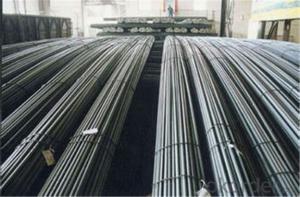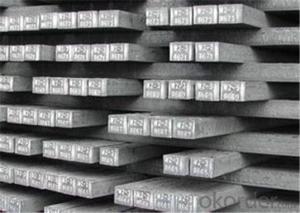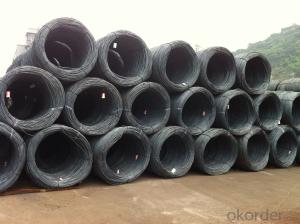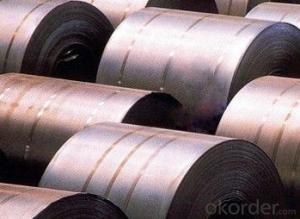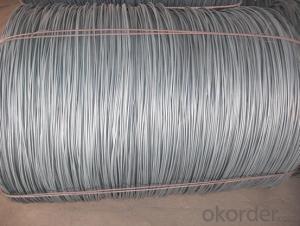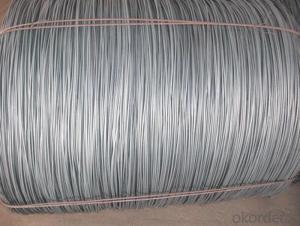Square Steel Billet Hot Sale Q275B/5SP in China
- Loading Port:
- Tianjin
- Payment Terms:
- TT OR LC
- Min Order Qty:
- 600 m.t.
- Supply Capability:
- 45555555 m.t./month
OKorder Service Pledge
OKorder Financial Service
You Might Also Like
Item specifice
Description of steel billet:
Our company is recognized by ISO9001:2008
1. hot rolled wire rod
2. material: Q195-235
Festures of steel billet:
1. Drawn wire specialist, your wire rod solution
2. ISO9001 Certified Mill &SGS
3. Feature: machinability, high hardness, toughness, corrosion resistant
Specifications of steel billet:
Name: | steel billets |
LENGTH: | 6 meter to 12 meter (+ 50mm) |
Size: | 100*100, 120*120, 150*150, 200*200 |
Grade: | 3SP,5SP,Q235,20MnSi. |
Shape: | Square, Round |
Technique: | Hot-Rolled |
Standard: | ASTM/GB |
BENDING | No more than 5mm in 1 meter |
ANGULAR TWIST | No more than 1 degree per meter and not more than 6 degree over 12 meter length. |
Images of steel billet:
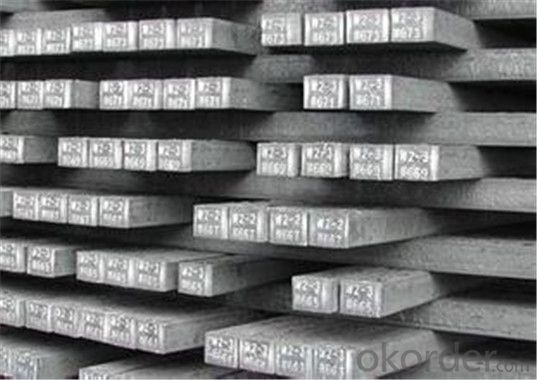
FAQ:
1. What is your package?
Packing situation: standard seaworthy packing or as customer required.
2. How long is the lead time?
Delivery time: 45 days after order confirmed.
3. What payment term do you accept?
Payment: T/T or L/C at sight.
- Q:How is the tensile strength of steel wire rod tested?
- The tensile strength of steel wire rod can be assessed through a method known as the tensile test or tension test. This test aims to ascertain the wire rod's ability to withstand tension by determining the maximum load or force it can endure without breaking. In the process of the tensile test, a representative sample of the steel wire rod is prepared through cutting it into a specific length. Subsequently, the sample is placed within a testing machine referred to as a tensile testing machine or universal testing machine. This machine comprises two jaws, one stationary and one movable, which securely grip the ends of the wire rod. Once the sample is suitably positioned in the testing machine, the movable jaw is gradually pulled away from the stationary jaw, exerting an increasing force on the wire rod. The machine gauges the force applied to the sample while simultaneously recording the resulting elongation or deformation of the wire rod. Throughout the duration of the test, the force and elongation are continuously monitored until the wire rod fractures. The maximum force applied just before the fracture is noted as the tensile strength of the steel wire rod. This value signifies the highest load or stress the wire rod can withstand without breaking. To ensure precise and dependable outcomes, multiple samples are typically tested to account for any variability in material properties. The average of these results is then considered as the representative tensile strength of the steel wire rod. In conclusion, the tensile strength of steel wire rod is determined through a controlled testing process utilizing a tensile testing machine. This machine measures the maximum force applied to the sample before it fractures, providing valuable insights into the material's strength and performance.
- Q:What are the main factors influencing the choice of steel wire rod manufacturer?
- The choice of a steel wire rod manufacturer is influenced by several key factors. These factors encompass quality, price, reliability, production capacity, technical expertise, and environmental practices. Firstly, the quality of the product is a primary consideration for customers. They seek manufacturers that produce steel wire rods that meet their specific requirements and standards. Factors such as strength, durability, and consistency play a crucial role in this decision. Secondly, price is an important factor. Customers compare prices offered by different manufacturers to find the best value for their money. However, it is essential to consider price in relation to product quality and overall service provided by the manufacturer. Thirdly, reliability and reputation play a significant role in the decision-making process. Customers prefer manufacturers with a proven track record of consistently delivering high-quality products on time. Positive customer reviews and references from trusted sources greatly influence their choice. In addition, customers consider the production capacity and capabilities of a manufacturer. Depending on their specific needs, they may require a manufacturer that can produce large quantities of wire rods within a specified timeframe. Customization options and variations of the product may also be taken into account. Moreover, strong technical expertise and excellent customer support are valued by customers. Manufacturers that can provide technical guidance, assist with product development, and offer after-sales support are seen as valuable partners in the purchasing process. Lastly, environmental and sustainability practices have become increasingly important. Customers prioritize manufacturers that adopt sustainable production methods, minimize waste and emissions, and comply with environmental regulations. To summarize, the choice of a steel wire rod manufacturer is influenced by factors such as quality, price, reliability, production capacity, technical expertise, and environmental practices. Customers carefully evaluate these factors to ensure they select a manufacturer that can meet their specific requirements and provide a high-quality product and service.
- Q:What are the common applications of low alloy and oil tempered steel wire rod?
- Low alloy and oil tempered steel wire rod have a wide range of common applications in various industries. One common application is in the manufacturing of automotive components. Low alloy and oil tempered steel wire rod is used to make springs, such as suspension springs and valve springs, which are crucial for the proper functioning of vehicles. The high strength and durability of these steel wire rods make them ideal for withstanding the demanding conditions and heavy loads experienced by automobiles. Another common application is in the construction industry. Low alloy and oil tempered steel wire rod is used to make reinforcing bars (rebars), which are essential for reinforcing concrete structures like buildings, bridges, and highways. The strength and ductility of these steel wire rods ensure that the reinforced structures can withstand the stresses and pressures they are subjected to, providing stability and longevity. In addition, low alloy and oil tempered steel wire rod is also used in the manufacturing of various industrial equipment and machinery. These steel wire rods are commonly used to make wire ropes, which are used in cranes, elevators, and other lifting equipment. The high tensile strength and resistance to corrosion of these steel wire rods make them suitable for withstanding heavy loads and harsh environments. Furthermore, low alloy and oil tempered steel wire rod finds applications in the production of wire mesh, fencing, and other wire products. The strength and durability of these steel wire rods ensure that the wire products can withstand external forces and provide security or containment in various settings, such as construction sites, agricultural fields, and industrial facilities. Overall, the common applications of low alloy and oil tempered steel wire rod include automotive components, construction reinforcement, industrial equipment, and wire products. The unique properties of these steel wire rods, such as high strength, durability, and resistance to corrosion, make them versatile materials that contribute to the functionality and reliability of various products and structures.
- Q:How are steel wire rods stored to prevent corrosion?
- To minimize exposure to moisture and air, which are the main factors leading to corrosion, steel wire rods are typically stored. To prevent corrosion, the rods are commonly kept in a dry and well-ventilated area, far from coming into direct contact with the ground or any potential sources of moisture like water pipes or damp walls. Often, they are placed on pallets or racks, permitting proper airflow and avoiding contact with any surface that might contain water or excessive humidity. Moreover, a protective layer such as oil or a rust preventive compound is often applied to the steel wire rods to provide additional protection against corrosion during storage. It is also crucial to conduct regular inspections and maintenance to ensure that the storage conditions remain optimal and promptly address any signs of corrosion.
- Q:How is the microstructure of steel wire rod analyzed?
- The microstructure of steel wire rod is typically analyzed using various techniques such as optical microscopy, electron microscopy (scanning electron microscopy or transmission electron microscopy), and X-ray diffraction. These techniques allow for the examination of the grain structure, inclusion content, and other microstructural features of the steel wire rod.
- Q:How is steel wire rod used in the manufacturing of wire forms for transportation vehicles?
- Steel wire rod is an essential component used in the manufacturing of wire forms for transportation vehicles due to its strength, durability, and flexibility. It is used in various applications, including the production of springs, suspension systems, cables, and other critical components. One of the primary uses of steel wire rod in transportation vehicles is for the production of springs. Springs play a crucial role in absorbing shocks and vibrations, providing stability and comfort to the vehicle. Steel wire rod is commonly used to manufacture coil springs, leaf springs, and torsion bars. The high tensile strength and elasticity of the steel wire rod allow these springs to withstand heavy loads and provide a smooth and reliable ride. Another application of steel wire rod is in the production of suspension systems. Suspension systems are responsible for supporting the weight of the vehicle and maintaining contact between the tires and the road surface. Steel wire rod is used to create suspension components such as stabilizer bars and control arms, which help to improve the vehicle's handling, stability, and overall performance. Steel wire rod is also used in the manufacturing of cables for transportation vehicles. Cables are essential for various functions, including the operation of brakes, accelerators, and clutch systems. The high strength and durability of steel wire rod ensure that these cables can withstand the forces and stresses involved in vehicle operation, providing reliable and precise control. Furthermore, steel wire rod is used in the production of other wire forms, such as wire mesh or wire ropes, which have various applications within transportation vehicles. Wire mesh is used for reinforcing structures, providing protection, and enhancing safety. Wire ropes are used for lifting heavy loads, towing, and securing cargo. In summary, steel wire rod is a vital material used in the manufacturing of wire forms for transportation vehicles. Its strength, durability, and flexibility make it suitable for various applications, including springs, suspension systems, cables, and other critical components. The use of steel wire rod ensures that transportation vehicles are safe, reliable, and perform optimally.
- Q:How is steel wire rod used in the production of wire ropes for mining applications?
- Steel wire rod is an essential component in the production of wire ropes for mining applications. Wire ropes used in mining are subjected to extreme conditions such as heavy loads, high tension, and harsh environments. Steel wire rods provide the necessary strength and durability to withstand these demanding conditions. Firstly, steel wire rod serves as the raw material for manufacturing wire ropes. The rod is generally made from high-quality carbon or alloy steel, ensuring the necessary strength and resilience required for mining operations. The rod is then processed through various stages such as hot rolling, cold drawing, and heat treatment to achieve the desired mechanical properties. Once the steel wire rod is processed, it is transformed into wire strands, which are then twisted together to form wire ropes. The strands are carefully constructed to withstand the high tension and heavy loads typically encountered in mining applications. The number of strands and the arrangement of wires within each strand are carefully selected to meet the specific requirements of the mining operation, taking into consideration factors such as load capacity, flexibility, and resistance to fatigue. Furthermore, steel wire rod contributes to the corrosion resistance of wire ropes used in mining. Mining environments often expose equipment to corrosive elements such as water, chemicals, and abrasive materials. Steel wire rods are typically coated or galvanized to provide a protective layer against corrosion, ensuring the longevity and reliability of the wire ropes even in harsh conditions. In mining applications, wire ropes are predominantly used for hoisting, hauling, and lifting heavy loads, such as mining equipment, ore, and personnel. The strength and flexibility provided by steel wire rods allow wire ropes to securely transport these loads over long distances and rough terrains. Additionally, wire ropes are crucial for ensuring the safety of personnel working in mines, as they are used for suspending platforms, securing mine shafts, and facilitating emergency rescues. In conclusion, steel wire rod plays a vital role in the production of wire ropes for mining applications. Its strength, durability, and corrosion resistance make it an ideal material for withstanding the extreme conditions encountered in mining operations. Wire ropes manufactured from steel wire rods provide the necessary load capacity, flexibility, and safety required for efficient and reliable mining operations.
- Q:How does the quality of steel wire rod affect the performance of wire products?
- The performance of wire products is heavily influenced by the quality of the steel wire rod. The strength and durability of wire products directly depend on the quality of the steel wire rod. When high-quality steel wire rods are used, they are made from superior materials and undergo strict manufacturing processes. As a result, they have enhanced tensile strength and resistance to deformation. This ensures that wire products can bear heavy loads, tension, and stress without breaking or losing shape. On the other hand, low-quality steel wire rods are more prone to breakage, stretching, or bending under similar conditions. This compromises the performance of the wire products and can potentially lead to hazardous situations. The overall performance of wire products is also affected by the surface finish of the wire rod. Precise manufacturing techniques are used to achieve a smooth and uniform surface finish, which reduces friction and abrasion during the use of wire products. This not only extends their lifespan but also improves their functionality. In contrast, wire rods with poor surface finish may have rough or uneven surfaces, resulting in increased friction and wear. This can lead to premature degradation, decreased performance, and potential safety hazards. Additionally, the chemical composition of the steel wire rod has an impact on the corrosion resistance of wire products. High-quality wire rods are typically made from corrosion-resistant materials or have protective coatings, which prevent rust or corrosion over time. This is particularly important for wire products used in outdoor or moist environments where exposure to water, humidity, or chemicals may occur. Wire products made from low-quality wire rods with inadequate corrosion resistance can deteriorate faster, leading to decreased performance, structural weakness, and potential failure. To summarize, the quality of the steel wire rod directly affects the performance of wire products. Opting for higher quality wire rods ensures the production of stronger, more durable, and longer-lasting wire products. These products have enhanced resistance to deformation, improved surface finish, and better corrosion resistance. Investing in high-quality steel wire rods guarantees the production of wire products that meet performance standards, provide reliable functionality, and ensure user safety.
- Q:How does the magnetic properties of steel wire rod vary with different grades?
- The magnetic characteristics of steel wire rod can differ significantly depending on the grade. The magnetic behavior of steel primarily depends on its composition and microstructure, both of which can be modified in various ways to achieve different grades. Generally, steel wire rods with a higher carbon content tend to possess lower magnetic properties. This is because carbon atoms disrupt the alignment of the steel's magnetic domains, resulting in a decrease in overall magnetic strength. As a result, low carbon steel grades, like AISI 1006 or SAE J403 Grade 1006, typically display weaker magnetic properties. Conversely, steel wire rods containing higher levels of alloying elements, such as chromium, nickel, or manganese, usually exhibit enhanced magnetic strength. These alloying elements can affect the microstructure of the steel, promoting the formation of magnetic domains and improving magnetization overall. Stainless steel grades, which contain significant amounts of chromium and nickel, often demonstrate stronger magnetic properties compared to low carbon steel grades. It is important to note that while certain steel grades may inherently possess stronger or weaker magnetic properties, the specific manufacturing processes and heat treatments employed during the production of wire rods can also influence magnetic behavior. Different heat treatments can modify the microstructure and induce the precipitation of various phases in the steel, thereby impacting its magnetic properties. In conclusion, the magnetic properties of steel wire rod differ across various grades due to disparities in composition, alloying elements, and microstructure. Steel grades with higher carbon content generally exhibit weaker magnetic properties, while those with higher alloying elements tend to have increased magnetization. Additionally, the magnetic behavior of steel wire rod can also be affected by the specific manufacturing processes and heat treatments employed.
- Q:What are the common production processes for manganese-coated steel wire rod?
- The common production processes for manganese-coated steel wire rod include wire drawing, cleaning, manganese phosphating, drying, and coiling.
1. Manufacturer Overview |
|
|---|---|
| Location | |
| Year Established | |
| Annual Output Value | |
| Main Markets | |
| Company Certifications | |
2. Manufacturer Certificates |
|
|---|---|
| a) Certification Name | |
| Range | |
| Reference | |
| Validity Period | |
3. Manufacturer Capability |
|
|---|---|
| a)Trade Capacity | |
| Nearest Port | |
| Export Percentage | |
| No.of Employees in Trade Department | |
| Language Spoken: | |
| b)Factory Information | |
| Factory Size: | |
| No. of Production Lines | |
| Contract Manufacturing | |
| Product Price Range | |
Send your message to us
Square Steel Billet Hot Sale Q275B/5SP in China
- Loading Port:
- Tianjin
- Payment Terms:
- TT OR LC
- Min Order Qty:
- 600 m.t.
- Supply Capability:
- 45555555 m.t./month
OKorder Service Pledge
OKorder Financial Service
Similar products
New products
Hot products
Hot Searches
Related keywords
